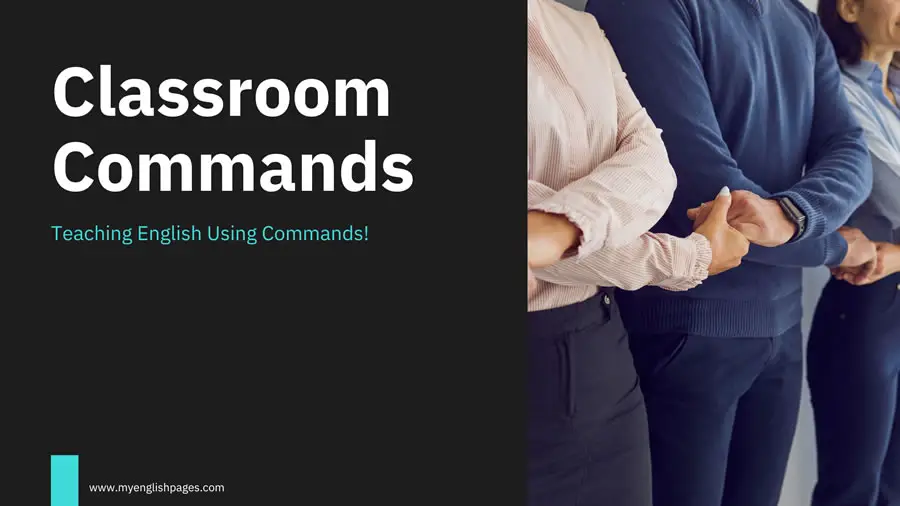Classroom commands are an essential part of language teaching, particularly for beginners who are just starting to learn a new language. By providing students with clear and simple commands to follow, teachers can help students connect physical actions with meaningful language use, which can aid in the acquisition of vocabulary, grammar, and pronunciation.
Table of Contents
Introduction
Using commands to teach English is one of the precepts of the Total Physical Response method, in which learners are not forced to speak until they are ready.
Classroom commands can also serve as a fun and engaging activity for students, helping to build confidence and promote collaboration and teamwork.
As a warm-up activity or as a more structured lesson, classroom commands are a valuable tool for language teachers at all levels.
Classroom commands
Beginner students may not be required to speak during the first sessions. Instead, they may just concentrate on obeying simple commands in the target language. The objective of these commands is to connect physical activity with meaningful language use as a way of instilling concepts. These command drills are usually used as receptive practice for different language points including grammar and vocabulary.
But are these types of activities appropriate only for beginners?
Yes, they are best for beginners and young learners but their effectiveness goes beyond these types of students. They may also incorporate more advanced language points such as the use of coordinators, comparatives and superlatives, etc
Teaching vocabulary using classroom commands
Commands can be used to teach vocabulary:
1. To practice classroom vocabulary items such as door, board, desks, teacher, students, book, pens, bag, ruler…
- Open your book.
- Close your notebook.
- Show me your ruler, pen, etc
2. To present the parts of the body (nose, head, hair, eyes, foot, tongue, etc.)
- Show me your nose, ear, etc.
- Put your hand on your head, nose, etc.
3. To teach adjectives such as big, small, red, blue, etc.
- Show me something big/small, tall/short, long/short, heavy/light, fast/slow.
- Point to something red/blue/green/yellow, etc.
- Hold up something soft/hard, rough/smooth, hot/cold.
Teaching grammar using classroom commands
Classroom commands can be used to teach various grammar points. They can be used:
1. To teach pronouns (me, you, him, her, us, them…)
- Look at me, him, them, etc.
- Show her, us, etc.
2. To teach action verbs:
- Jump, walk, turn, stand up, raise up your hand, sit down, etc
3. To teach tenses (to practice the imperative)
- Stand up, clean the board, take off your jacket, etc
4. To teach prepositions:
- Walk around the chair/desk/table.
- Put the book/pencil under/on/next to the desk/chair.
- Stand between two students/on one foot/beside the window.
5. To teach comparatives and superlatives:
- Hold up two items and ask, “Which one is bigger/faster/taller, etc.?”
- Ask two students to stand up and compare them by saying, “Student A is taller/stronger/faster, etc. than Student B.”
- Use superlatives to describe different things in the classroom, such as “The whiteboard is the largest/the most important/the newest, etc.”
6. To teach conjunctions:
- Tell students to do one action, and then add “and” to connect it with another action, such as “Stand up and raise your hands” or “Walk to the door and touch your nose.”
- Use “or” to give students a choice, such as “Touch your toes or touch your nose.”
- Ask students to complete a sentence using “but,” such as “Stand up, but don’t touch the door.”
Advantages of using commands to teach English
Command drills can also be used as a nice icebreaker activity. They create a lot of fun in the classroom while students get to know each other’s names and respond physically to meaningful language use.
Using command drills in language instruction has benefits beyond simply acquiring vocabulary and grammar.
Additional benefits also include:
- Building confidence: Command drills provide students with a clear task to perform, which can help them feel more confident in their abilities. As they successfully follow the commands in the target language, they feel more comfortable understanding and using the target language and taking risks in the classroom.
- Improving listening skills: In order to follow the commands, students must actively listen and understand what the teacher is saying. This can help improve their receptive skills, as they learn to recognize word boundaries and sounds in the target language.
- Developing physical coordination: Command drills involve physical movement, which can help students develop their coordination and motor skills. This can be particularly beneficial for young learners who are still developing their fine and gross motor skills.
- Promoting teamwork and collaboration: Whole class command drills can promote teamwork and collaboration, as students work together to follow the commands and perform the actions. This can help build a sense of community in the classroom and encourage students to support each other in their language-learning journey.
- Providing a fun and engaging activity: Command drills can be a fun and engaging activity for students, particularly young learners. Students become more motivated if they integrate physical activity and play into language learning.
How to use command drills?
Command drills can take the form of:
- Individual commands.
- Whole class commands.
Whole class command drilling
After a short introduction of key vocabulary items like parts of the body, school things etc, you may use whole class command drilling. The vocabulary can be introduced simply by pointing to objects or by performing actions. Then,you may use commands like the following:
- Stand up/sit down.
- hold up your hands.
- show me your book/(blue) pen/ ruler/ear/eyes/mouth…
- Touch your head/shoulder/ear…
Individual command drilling
You may also use individual drills to help students introduce their names or to check students’ comprehension of vocabulary or grammar.
Here are examples of individual commands:
- Please, tell me what your name is / Please, your name…
- Ok, Leila, stand up, please.
- Go to the board.
- Walk to the door.
- Write your name.
- Write numbers 1, 2, 5, 8…
- Show me the window.
- Point to your classmate Lisa.
- Point to the teacher…
These commands eventually become more complex. For example, “Walk to the door” becomes “Stretch your arms while you walk to the door” or “Touch your ear while you write your name on the board”…etc Students later become more actively involved, verbally and creatively.
Conclusion
Classroom command drills can be used to introduce a wide range of language items for beginners By incorporating these commands they become able to understand and perform actions in the target language from the start.


